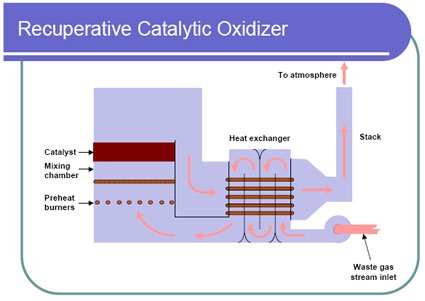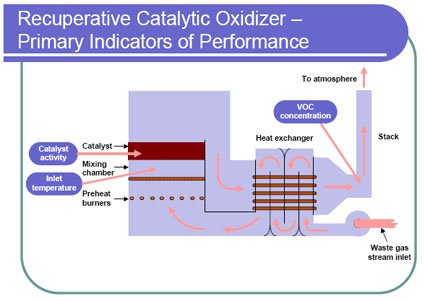Monitoring by Control Technique - Catalytic Oxidizer
Description
Catalytic oxidizers, also known as catalytic incinerators, are oxidation systems (similar to thermal oxidizers) that control VOC and volatile HAP emissions. Catalytic oxidizers use a catalyst to promote the oxidation of VOCs to CO2 and water (i.e., increase the kinetic rate). The catalyst therefore allows oxidation to occur at lower temperatures than for thermal oxidation; catalytic oxidizers generally operate between 650°F and 1000°F.
Important design factors for catalytic oxidation include temperature (an operating temperature high enough to oxidize the waste gas on the catalyst), residence time (sufficient residence time in the catalyst bed for the oxidation reaction to occur), turbulence or mixing of combustion air with the waste gas, VOC concentration and species, catalyst characteristics, and the presence of masking agents in the waste gas that can reduce the effectiveness of the catalyst bed.
To reduce fuel usage required for oxidation, catalytic oxidizers may have some form of heat recovery. The percentage of heat recovery in the design of catalytic oxidizers generally increases with decreasing inlet VOC/HAP concentration. Heat recovery may either be regenerative or recuperative. In regenerative heat recovery, hot exhaust gases and cool inlet gases are alternatively passed through a fixed bed, typically employing ceramics. In recuperative heat recovery, heat is recovered by passing the hot exhaust gases through a non-contact air-to-air heat exchanger to heat incoming air to the oxidizer.
For more information, see the box More About Catalytic Oxidizers.
Monitoring Information
The primary indicators of catalytic oxidizer performance are the outlet VOC or volatile HAP concentration, catalyst bed inlet temperature, and catalyst activity. Other indicators of catalytic oxidizer performance include temperature rise across the catalyst bed, catalyst bed outlet temperature, outlet CO concentration, exhaust gas flow rate, fan current, outlet O2 or CO2 concentration, and pressure differential across the catalyst bed.
The Compliance Assurance Monitoring (CAM) Technical Guidance Document (TGD) provides information on monitoring approaches for different types of control devices. Specific information provided in the CAM TGD related to catalytic oxidation include example CAM submittals based on case studies of actual facilities.
For more information, see the box More About Monitoring and the CAM Rule.
To search for additional monitoring information specific to an industry, see the monitoring information by industry type page.
Costs
Costs of catalytic oxidation are discussed in the EPA Air Pollution Control Cost Manual*, Section 3.2, Chapter 2 - Incinerators(64 pp, 182 K, About PDF). Costs of monitoring systems, both Continuous Emission Monitors and parametric monitoring systems, are addressed in the EPA Air Pollution Control Cost Manual*, Section 2, Chapter 4 - Monitors.(42 pp, 542 K, About PDF)
Costs for catalytic oxidation of styrene emitted from fiber-reinforced plastics facilities is discussed in a report titled, Assessment of Styrene Emission Controls for FRP/C and Boat Building Industries (EPA-600/R-96-109). The report includes spreadsheets designed to quickly analyze the control cost for a catalytic oxidizer (and other VOC/HAP control technologies) based on control device input flow rate and pollutant loading (in tons per year or ppm). An introductory text file lists the controls that are analyzed and gives basic instructions for using the spreadsheets. The spreadsheets were developed for styrene (C8H8, 4.326 mg/m3 per ppm, 0.00475 Btu/ppm) and would need to be altered to address other pollutants.
For more information, see the box Costs for Catalytic Oxidizers.

- Air Pollution Control Cost Manual*, Section 3.2, Chapter 2 - Incinerator(64 pp, 182 K, About PDF).
- More information on Thermal Oxidizers
- EPA Fact Sheet - Catalytic Incinerator, EPA-452/F-03-018 (PDF)(6 pp, 108 K, About PDF)
- Training Video - Air Pollution Control Devices - Vapor Incineration (MP4) (zip)
- Spreadsheets to Analyze Control Costs for Catalytic Oxidizers, from Assessment of Styrene Emission Controls for FRP/C and Boat Building Industries, EPA-600/R-96-109 (ZIP)(32 K, 1996) (available in Excel)
- Introductory Text; Assessment of Styrene Emission Controls for FRP/C and Boat Building Industries (EPA-600/R-96-109) (TXT) (zip) (1 p, 3 K)
- Assessment of Styrene Emission Controls for FRP/C and Boat Building Industries (EPA-600/R-96-109) (132 pp, 6 M, About PDF)
- Addendum to Assessment of Styrene Emission Controls for FRP/C and Boat Building Industries, EPA-600/R-96-136 (PDF)(59 pp, 3 MB, About PDF)

